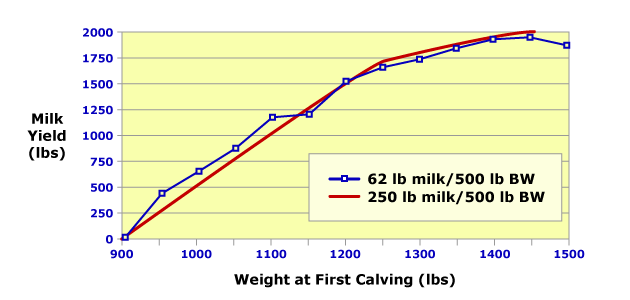Previous Page | Right click this page to print.
Nutrient Requirements
Some nutrients that we will talk about in the dairy section and also in the beef section, is net energy for maintenance which is abbreviated NEM, net energy for gain or NEG. These are newer, more preferable terms. However, in general, with dairy heifers, TDN is still quite common or total digestible nutrients. The units for net energy, whether it is maintenance or gain, is megacals. And that for TDN is kilograms. For crude protein, our units are grams per day or grams. Although we will not talk much about minerals and vitamins, it is important to always supplement these at requirement in heifer diets.
Nutrient requirements for energy. There are several. One is for maintenance.
All animals have a requirement for energy for maintenance and it is based
upon the surface area of the animal. So the larger the animal, the more
surface area and therefore the higher the requirement for energy. If you
look at dairy cows or even beef cows or other animals for that matter,
its body weight raised to either the two thirds or the three quarter power
is the most common. If we looked at the net energy maintenance requirement
for dairy heifers, it would be .86 times their body weight raised to the
three quarter power.
The energy requirement for growth depends upon the rate of gain. For Holstein heifers, our goal is about 1.7 lbs of gain per day. A reasonable goal in the dairy industry, is to calve heifers at about two years of age, weighing 1,350 lbs. We can calculate what the rate of gain of these animals should be. If birth weight is 95 lbs, that means that we must gain 1,265 lbs over 730 days or we must achieve 1.7 lbs of gain per day. Now the energy requirement depends upon two things, body weight and rate of gain. You will see a couple of coefficients, 0.035 times body weight. So that means, the larger the animal the more energy they need per unit gained. And also, average daily gain in grams divided by 1,000, plus one, times average daily gain divided by 1,000. The requirement per unit increases as body weight increases.
Requirements for protein. Again, maintenance requirements depends upon body weight. Larger heifers, older heifers, would need more protein for maintenance than younger heifers. It also depends upon the rate of gain. As animals gain more rapidly or gain more weight per day, their requirement per unit gain increases. Also, older animals are less efficient in converting protein to gain and so the requirement per unit gain increases as body weight increases.
For net energy, the differences in weights or age of animals is depicted on this graph.

The green bar shows the maintenance requirement of energy per day. And the yellow shows the requirement for gain of animals gaining 1.7 lbs per day. It ranges from 300 lbs to a 1,300 lb heifer. As body weight increases, maintenance requirement increases because animals weigh more. However, an interesting point is that the 1,300 lb heifer requires almost twice as much energy to gain 1.7 lbs per day as a 300 lb heifer. If you compare the yellow bars, about 2 megacals of energy per day to gain 1.7 lbs for the 300 lb heifer and about 4 megacals per day for the 1,300 lb heifer to gain 1.7 lbs per day. Why does it take more energy to get a pound of gain on a 1,300 lb heifer versus a 300 lb heifer? Well, the answer is the composition of the gain. The 1,300 lb heifer is gaining much more fat versus protein at this point. Fat is more energy dense, and therefore requires more energy per unit gained. Gain is more efficient in smaller animals versus heavier animals. And the same could be said for protein requirements.
What weight do we want to calve these animals at? This graph shows that the optimal calving body weight is about 1,450 lbs for Holstein heifers.
 The gain in
milk yield is pretty steep, up to about 1,250 lbs. We gain about 250 lbs
of milk for every 500 lb increase in body weight. Once the heifer reaches
about 1,250 lbs, the gain in additional production is only about 62 lbs
for 500 lbs of body weight. And actually, as heifers get larger than 450
lbs, we actually lose milk production mainly because of overconditioned,
overweight, obese heifers.
The gain in
milk yield is pretty steep, up to about 1,250 lbs. We gain about 250 lbs
of milk for every 500 lb increase in body weight. Once the heifer reaches
about 1,250 lbs, the gain in additional production is only about 62 lbs
for 500 lbs of body weight. And actually, as heifers get larger than 450
lbs, we actually lose milk production mainly because of overconditioned,
overweight, obese heifers.
Previous Page | Right click this page to print.